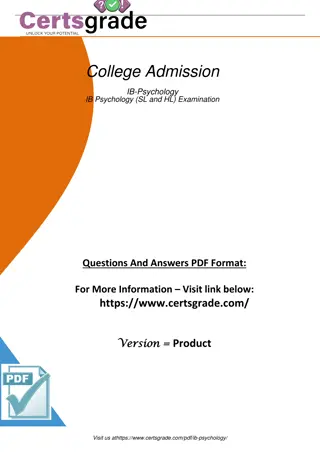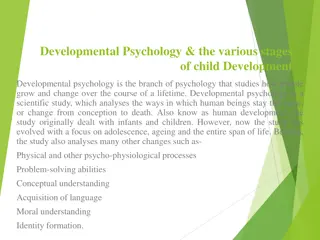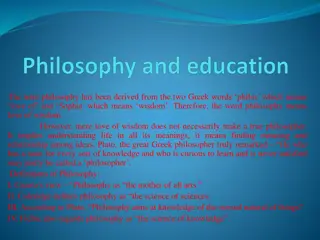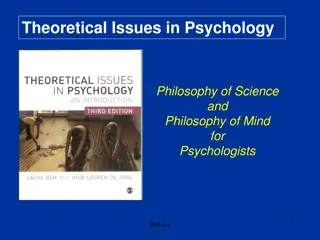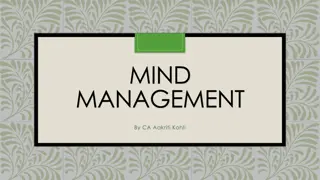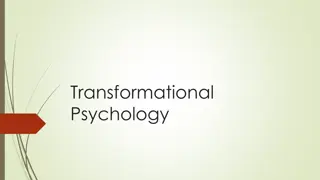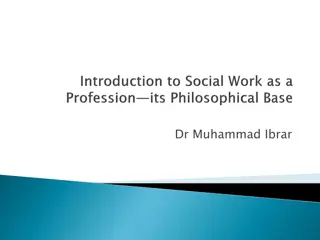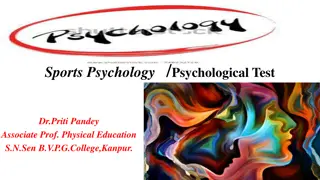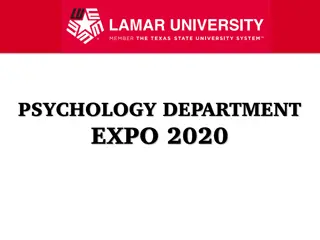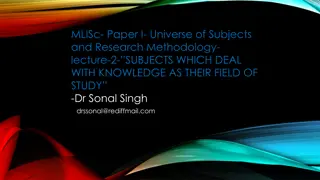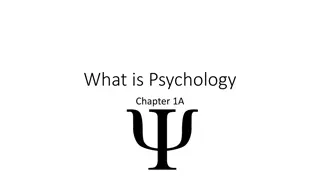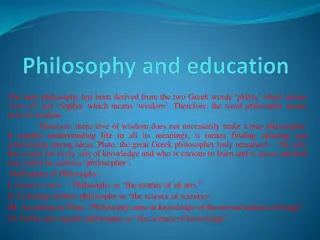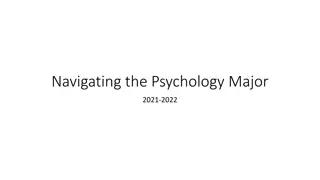Modern Perspectives on the Philosophy of Mind in Psychology
Explore modern approaches to the philosophy of mind in psychology, including functionalism, the mind-brain identity theory, and the challenges faced by functionalists. Functionalism emphasizes the functional aspect of mental processes and their potential realization in various physical devices, while also highlighting the autonomy of mental explanations. This philosophy of mind provides a new perspective that opposes dualism, identity theory, behaviorism, and reductionism.
Download Presentation

Please find below an Image/Link to download the presentation.
The content on the website is provided AS IS for your information and personal use only. It may not be sold, licensed, or shared on other websites without obtaining consent from the author. Download presentation by click this link. If you encounter any issues during the download, it is possible that the publisher has removed the file from their server.
E N D
Presentation Transcript
Theoretical Issues in Psychology Philosophy of Science and Philosophy of Mind for Psychologists B&LdeJ 1
Chapter 7 Modern approaches to mind (1) Functionalism Fodor s computational theory of mind The language of thought Problems of LOT and AI Searle s Chinese room argument B&LdeJ 2
Two modern versions of materialism: identity and functionalism The MIND-BRAIN IDENTITY THEORY (IT) mental process brain process FUNCTIONALISM no reduction of mind to brain: mental process can be realized in physical process (brains, computers, or ...), but not necessarily brain process; therefore implementation of cognition can be neglected. B&LdeJ 3
Problems of the IT according to functionalists We have too little knowledge for such a radical identification: no type-identity, but token identity. IT threatens psychology s autonomy. IT is too chauvinistic : only people like us, with the same neuro-physiological make-up, can have mind, intelligence, etc. B&LdeJ 4
Functionalism: the philosophy of mind of the first cognitive revolution First cognitive revolution ca 1960 ca 1980. Internal mental processes are scientifically legitimate (vs. behaviourism). Mental processes are functional states of a machine. Functionalism is a one-level (design-stance) philosophy of mind. Computation, information processing; the mind uses a language of thought. Mind (intelligence) is software and could be materially realized in various hardware-devices (human brains, computers). Hence, functionalism as philosophy goes hand in glove with AI. B&LdeJ 5
Functionalism presented itself as a new philosophy of mind Opposing dualism: materialism: token identity, every function can be realised in something physical. Opposing identity theory: no type identity, functions can be multiply realised. Opposing behaviourism: mental processes do exist, are causes of behavior. Opposing reductionism: mental (functional) explanations are autonomous; no reduction to neuroscience. B&LdeJ 6
Functionalism: functions as in software Mental processes are functions: the focus is on what they do, as in computer programs (memory, retrieval etc.). Just like computer programs can be considered apart from hardware,mental processes can be studied apart from the brain. Mental states are functional / causal roles: they have causal relations with input (information), output (behavior), and other mental states (e.g. hunger: she is hungry so she can only think of food now, and raids the fridge). B&LdeJ 7
Functionalism: multiple realization Multiple realization implies anti-reductionism Multiple realization: the same mental process (functional state) can be realized in different physical systems (human or animal brain, computer hardware, etc.) E.g.,hunger in humans and octopusses: the same functional state, the same causal role (looking for food), but realized in different nervous systems (or computational machinery). So, cognitive functions occur at an autonomous level distinct from the physical realization (implementation); and can be studied without neurophysiology. B&LdeJ 8
Computational Theory of Mind (CTM) by Jerry Fodor Classical or orthodox philosophy of cognition (cognitivism). Sources: Chomsky s innate and generative grammar; computer science and AI; philosophy of language and logic; philosophy of mind: functionalism. Main features: computationalism; language of thought . B&LdeJ 9
CTM: the main features (1) Thinking is manipulation of mental symbols. Mental states, i.e. thoughts, beliefs, desires and repre- sentations, are codified in abstract symbols of a formal language (cfr formal logic) which form symbol strings (cfr computer language). Thinking is computation on these symbol strings, producing more symbol strings. Computation is following algorithms, i.e. series of formal operations, according to formal, i.e. syntactical rules. These formal syntactical processes mirror semantics, i.e., meaning and representing (intentionality). B&LdeJ 10
Language of thought Is a sort of formal computer language in the head. A language abstracted and formalized into symbols. Arranged in mental propositions. Operations with these propositions are formal, i.e. they follow formal rules (syntax) as in logic. Not with regard to content, meaning (semantics). Thoughts (representations) are logical formulae in the head (cfr. Chomsky s generative grammar). This is inborn (wired-in) mentalese . B&LdeJ 11
The linguistic inspiration: the proposition A proposition is the linguistic (philosophy of language) term for a statement in which something is affirmed or denied, and which can therefore be either true or false. e.g. He came in just after midnight. She was not too frightened. The early philosophy of cognition has adopted this concept of proposition to refer to mental states/representations: mental propositions (mental sentences). B&LdeJ 12
The logical inspiration: formality, syntax Logic is a formal science: for a proposition we can write a symbol: p, q, r etc. With these symbols and symbols for logical operators (e.g., > for implication: if ... then; ~ for negation: not) you can set up forms of reasoning, logical rules, e.g., (x)(Hx > Mx) Hs Ms p>q p q p>q ~q ~ p These are logical forms (rules): they apply due to the form only (syntax); not as a result of the content or the meaning (semantics) of the symbols: you can fill in whatever proposition ( e.g., p: it is raining; q: the streets are becoming wet). B&LdeJ 13
CTM: folk psychology and intentionality Folk psychology CTM s wants to explain beliefs and desires, as in folk psychology: e.g., he withdraws his money from the bank, because he believes the bank will collapse and desires not to lose his money. Beliefs and desires are intentional states. CTM: beliefs and desires are representations in the language of thought. In this way folk psychology is justified by CTM. CTM explains folk psychology, in more or less the same way as physics explains common sense view of physical processes. B&LdeJ 14
CTM: folk psychology and intentionality Intentionality: intentionality can be explained mechanically; thinking is mechanical as in computers; no homunculus is needed; intentionality works in a physical system; this offers a naturalistic explanation of intentionality, i.e. how thinking causes behavior; is the Brentano-problem (How is thinking / intentionality possible in a mechanical way?) solved ? (cfr. Searle: No! No intentionality or meaning in formal- syntactic machines. ) B&LdeJ 15
CTM: problems LOT and AI (1) Formality condition (only formal structure determines behavior); what about meanings: syntax mirrors semantics ; but how? Hence: methodological solipsism , i.e., internalism and individualism: psychology ends at the skin; meanings play no causal role. Representations can cause other thoughts and behavior, without referring to objects in the world (their meaning). The syntax of representations is more important than their semantics. e.g., Barbara s belief in Dracula may cause her desire to see him, leave the window open and hide the crucifix, though (probably) Dracula does not exist! B&LdeJ 16
CTM: problems LOT and AI (2) Are rationality/intelligence, and also intentionality possible in computational systems? Has a computer knowledge, representations? E.g., MYCIN: medical diagnostic program, but does not know/understand anything about health/sickness, physiology, anatomy etc. What about consciousness in mechanical devices, computers? B&LdeJ 17
John Searle: the Chinese room argument Fodor s CTM: thinking and understanding (intentionality) is pushing meaningless symbols according to formal syntactical rules. Searle: but pushing symbols is no garantee for understanding: evidence The thought experiment of the Chinese Room In a locked room: an English speaker without any knowledge of Chinese. Input: Chinese symbols: questions. He has an instruction book how to proceed (program). output: Chinese symbols: answers. He simulates Chinese q&a; answers are correct (cfr. Turing test). But he still doesnot understand any of the Chinese symbols. B&LdeJ 18
The Chinese Room ? Questions in Chinese Book of instructions Searle Non-Chinese speaker I still don t understand Answers in Chinese B&LdeJ 19
John Searle: the Chinese room argument Therefore (Searle) CTM must be wrong: manipulating uninterpreted symbols does not produce understanding, meaning, intentionality. Searle, a machine can think, and be conscious, but only if that machine is a biological brain. 20


![[PDF⚡READ❤ONLINE] Zen Mind, Beginner's Mind: 50th Anniversary Edition](/thumb/20459/pdf-read-online-zen-mind-beginner-s-mind-50th-anniversary-edition.jpg)


